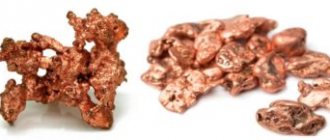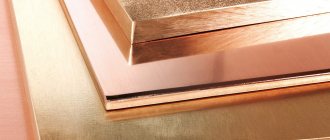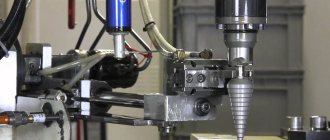First of all, you need to understand what it means to protect brass from oxidation, and then we’ll talk about why it’s needed and how to do it yourself. If we use more precise terminology, this process is called passivation of metals, that is, after treatment, the surface of the product becomes passive and does not react with the environment, or, more simply, does not oxidize.
Source drilling-moscow.rf
Types and advantages of brass products
Products made from brass are famous for their durability and wear resistance when cared for with care and properly coated. Coating often involves applying a top protective layer directly to the metal itself. The choice of protective layer depends directly on the conditions of use of the product. If we talk about buildings or plumbing, the coating materials in this case are zinc, aluminum, chromium, nickel, etc. Also, the protective layer can have a decorative function when it comes to products for interiors or luxury items. To do this, manufacturers can plate brass products with silver or gold by sputtering.
Does brass rust? No, it doesn’t. An important advantage of brass (even a classic alloy without impurities and additives) among other metals is that it does not rust, but only darkens, loses its mirror shine, and oxidizes. Therefore, this metal was widely used and is still used to make faucets, basins, bathtubs, buttons, dishes, orders, medals, figurines, candlesticks, frames for large mirrors or paintings, bases for glass tables, various decorations, etc.
Rules for caring for the alloy at home
Before you start cleaning the product, it is important to make sure that it is accurately made of brass. Many objects appear to be brass in appearance and tactile sensations, but are made of similar metals. To check, you need to attach a magnet to the surface, and if it does not stick, then it is brass.
If an item begins to fade over time, it is not necessary to clean it. Darkening does not always mean that the top layer has begun to oxidize, and such an external change has its own attractiveness.
To protect the product without extensive cleaning, simply coat it with a polishing compound and lightly wipe it.
Methods and means for cleaning brass
In order to give the product its original appearance, you need to know how and with what to clean brass at home. When choosing a purchased cleaning product, be sure to pay attention to the composition and acids contained in it. Each of the acids interacts with metals differently, so the probability of destroying the protective layer along with oxidation is quite high.
What is not recommended to use
To avoid damage and destruction of the protective coating, you need to know about the products that are not recommended for use when cleaning brass. Therefore, first we list the substances that are dangerous to brass:
- Vinegar or acetic acid. When interacting with this acid, products made from “eternal” metal undergo dezincification and acquire a bright red color.
- Sandpaper. Even with the smallest abrasive size, sandpaper can not only scratch the item, but also remove part of the protective coating.
You need to be very careful with store-bought chemicals. Pre-cleaning is, of course, necessary. But before you start the process , you must be familiar with the components of the product. Strong chemicals can not only corrode and destroy the top layer, but also change its structure. Watch the brass and do not leave it in a chemical solution for a long time if you decide to clean it using chemicals.
Compositions that will not harm the surface
Before any cleaning, you should verify the composition of your product. Brass may be a metal, but it does not react to a magnet. Therefore, if your product is magnetic, then you should conclude that the composition contains impurities. This means that the cleaning method should be selected carefully to protect the product from damage . If you are completely sure of the composition of the product, then cleaning can be done using the following means:
- Oxalic (ethanedioic) acid or cleaning agents or detergents that contain it. In its pure form, oxalic acid requires 200 g per 10 liters of water. For such a solution, plastic containers are best suited, since metal containers can be exposed to acid. There are two ways to prepare this solution: in cold or hot water. The “cold” method involves completely immersing the product in a solution and periodically monitoring the cleaning process, since this method can take several days. The “hot” cleaning method involves using hot water for the solution. The temperature of the water that flows from the tap will be quite sufficient. Using higher temperature water increases the risk of damage to the paint or the top protective layer, if any. The product should be completely immersed in the solution, otherwise the edges located above the level of the solution will begin to oxidize very quickly due to the combination of acid vapors with oxygen. It is also necessary to maintain the temperature by placing a plastic container with the solution in a hot bath. The time for the first procedure is 20-40 minutes; if necessary, the process can be repeated, reducing the time the product remains in the solution. The prepared solution for subsequent procedures can be stored in plastic containers: bottles or buckets with lids.
- Acetone. A cotton swab is moistened with acetone and wiped over the entire surface of the product. But this method is not suitable for varnished brass products.
- Formic acid. Cleaning is less effective, but possible. 30% acid is sufficient for cleaning. The effect is lower due to the rapid weathering of the component, but, on the other hand, it is gentle and ensures the safety of the product.
- Salt. Ancient cleaning method: 1 tbsp. l. for 1 glass of whey.
- Solutions of ammonia and ammonium carbonate. 10−15% is enough.
- Lemon juice with salt. Squeeze the juice of half a lemon, add a pinch of salt. Apply the resulting solution to the product. Lemon juice usually does the job of cleaning.
Zinc alloy: special properties and main varieties
Thanks to archaeological excavations, it was discovered that zinc products began to be used around the 7th century AD. This metal was very common due to a number of useful properties. Zinc alloy can be made from various substances, which determine its characteristics. This material is used in various industries, including jewelry.
Properties and characteristics of zinc and zinc alloys
The characteristics of zinc alloys are largely determined by the properties of zinc. This metal is bluish in color, is not found in its pure form, and usually contains impurities that change its properties. Pure metal is obtained as a result of several reactions.
Zinc has the following chemical properties:
- When heated, it reacts with hydrogen sulfide and water to release hydrogen.
- Does not react with nitrogen and carbon.
- It reacts with alkalis to form zinc acid salts - zincates.
Zinc is a very durable material. Its ductility increases when heated. If it is heated by more than 210 degrees, this may change its shape. At low temperatures the substance melts.
What does zinc alloy look like?
The amount of impurities depends on the methods of metal extraction, the characteristics of its processing and the zinc grade. Most often you can find impurities in the form of nickel, chlorine, fluorine and lead. Usually, when creating zinc alloys, pure zinc is used, since the presence of impurities degrades the quality of the material:
- tin makes the alloy too brittle and brittle;
- in the presence of cadmium, the ductility of the material decreases;
- lead increases intercrystalline corrosion of the material and promotes its dissolution in acids;
- the presence of iron increases the hardness of alloys, but reduces their ductility;
- Arsenic causes the alloy to become brittle and non-ductile.
Therefore, to improve the characteristics of zinc alloys, zinc is first purified from impurities. And then they use pure metal, which is alloyed with various components.
Advantages and disadvantages
Most zinc alloys have the following advantages:
- they are very durable and are not damaged by mechanical stress;
- resistant to corrosion;
- have good casting qualities and can be used to create even small elements;
- Over time, they practically do not age.
However, even small amounts of impurities worsen the characteristics of the alloy. They lead to a decrease in melting point, swelling, and contribute to the appearance of cracks. Therefore, zinc alloys must be created in compliance with all technologies, and the amount of impurities in them should not exceed 0.005%.
Many people ask whether zinc alloys darken or not? This is another drawback of the material. Zinc alloys may darken over time. Moreover, the darkening usually spreads over the entire surface of the material.
This is caused by the formation of an oxide film on the surface of the material. It forms at room temperature after contact with air or water.
Therefore, to avoid this, electroplating is required.
Types of zinc alloys
Zinc can be alloyed with various substances, which will determine the properties of the resulting material. Alloying pure zinc with copper, aluminum and tin can improve its performance. The resulting composition will be of higher quality than the pure substance.
Copper and zinc
The copper-zinc alloy is called brass. This alloy has been known for a very long time. It was first made by alloying zinc ore and copper. It was only in the 18th century that an alloy of copper and zinc metal was first created.
Moreover, both components can be taken in different proportions. As a result, several types of brass are distinguished:
- Green. Contains 60% copper and 40% zinc.
- Golden. It contains 75% copper and 25% zinc.
- Yellow. Contains 67% copper and 33% zinc.
Brass is an alloy of copper and zinc
Brass lends itself well to pressure processing. It is characterized by high mechanical properties and good corrosion resistance. But in air, in salt water and carbon dioxide solutions, brass is unstable and quickly becomes covered with a dark oxygen film.
Externally, brass looks more beautiful than copper and is characterized by better corrosion resistance. But as the temperature rises, the intensity of corrosion also increases. It can be triggered by high air humidity, the presence of ammonia or sulfur dioxide. Therefore, to prevent corrosion, the material is subjected to low-temperature firing.
Brasses do not lose their properties when the temperature drops. This allows them to be used as a structural material. But at high temperatures (more than 200 degrees), phenomena of brittleness of brass can be observed.
Tin and zinc
The alloy of zinc and tin is characterized by high protective properties. Does zinc alloy with tin rust or not? This material is very resistant to corrosion. An alloy with 20-25% zinc and 75-80% tin has the best anti-corrosion properties.
Therefore, it can be used in conditions of high humidity, and its appearance will not deteriorate over time. The higher the zinc content in the alloy, the lower its corrosion resistance.
If the alloy contains 50% or more zinc, its corrosion resistance is close to that of pure zinc.
The alloy of tin and zinc has the following advantages:
- It is very ductile and can be easily soldered.
- The polishing of the deposit lasts for a long time.
- Has high corrosion resistance.
Due to the presence of the above properties, an alloy of tin and zinc is usually used in the electrical and radio industries. Products made from it are very durable and resistant to external influences.
Aluminum and zinc
Most often, an alloy of zinc, aluminum and copper is created, which is called TsAM. It also contains a small amount of magnesium.
This alloy has a low melting point and is easy to cast. Products made from it are very durable and resistant to the environment.
There are several high-quality zinc-aluminum alloys, which are designated TsAM 4-1, TsAM 4-3, TsAM 10-5 and others. They contain approximately the same amount of aluminum, but different amounts of magnesium, nickel and copper. The cost of an alloy of aluminum and zinc is lower than that of tin and zinc. Therefore, products made from it are much cheaper.
Scope of application
Zinc alloys are widely used. They are used in the following industries:
- In the automotive industry. Door handles, mirrors, and parts for car interior decoration are made from zinc alloys.
- When creating jewelry. Zinc is alloyed with gold, thereby increasing its ductility and malleability. This makes it easy to connect small parts to each other.
- In medicine. Zinc alloys are used to make medical furniture and devices. And zinc oxide is a good antiseptic, so it is added to various ointments and medicines.
Zinc alloy is used in automobile manufacturing
Thus, zinc and its compounds are used in many fields. But the substance is most widely used in the automotive industry.
Types of zinc alloys by purpose
According to their intended purpose, zinc alloys can be of several types:
- Deformable. 15% - aluminum, 5% - copper, more than 1% - magnesium. It is made in the form of sheets or rods. The properties are similar to brass.
- Foundries. They are made by adding 3-4% copper and aluminum to zinc, as well as 0.05% magnesium. They have good fluidity. Therefore, they are manufactured through injection molding or mold casting.
- Anti-friction. They contain 10% aluminum, 5% copper and 0.1% magnesium. Manufactured by injection molding. They have a low coefficient of friction and are used in the automotive industry.
- Solders. They are used for soldering aluminum parts. Usually include impurities - metals. This increases their strength.
- Typographic. They contain 7.5% aluminum, 2% magnesium and approximately 4% copper. Such alloys are very durable and cast well into molds.
- Protective. They contain no more than 1% aluminum and a tiny amount of silicon and magnesium. Resistant to corrosion even in damp environments. Therefore, such alloys are used as protective materials.
Zinc alloys have proven themselves well and are widely used. But when creating them, proportions must be accurately taken into account, otherwise poor quality material will be obtained.
Zinc alloy in jewelry
Externally, zinc alloys resemble noble metals. Therefore, they are used in costume jewelry to create inexpensive jewelry. Zinc alloy jewelry looks expensive but is easy to create.
Is zinc alloy harmful? In fact, it has no effect on the human body. But, nevertheless, it is better to purchase good quality jewelry. Usually, a special alloy is used to create jewelry, which is called costume jewelry. The most commonly used is brass or an alloy with aluminum. Externally, such products resemble gold and silver.
Is zinc alloy harmful in jewelry? No, so you can safely buy products made from it. After all, if it had a negative impact, making jewelry from it would be prohibited.
Thus, zinc and zinc alloys are widely available. They are used in medicine, automotive industry and even in jewelry. These are high-quality and sustainable materials that practically do not change under the influence of environmental conditions.
Polishing a cleaned product
The final step in the cleaning process is polishing the product. Polish the item using a dry cloth made from natural materials and non-abrasive chemicals. Instead of chemicals, you can use a “light” solution of flour, salt and 100 ml of vinegar water. For the solution you will need 100 g of salt, 100 g of flour and 100 ml of vinegar solution. Rub the solution on the surface of the object in a circular motion, but carefully monitor its changes. Vinegar can ruin things, so be careful.
Group: Forum Participants Messages: 28 Registration: 9.2.2011 From: Moscow User No.: 93566
Shut-off ball valves made of brass (sometimes made of bronze or stainless steel) are usually installed on the outlets of hot water and hot water risers. As you know, steel pipes and brass taps have different electrochemical potentials, therefore, at the steel-brass transition point, electrochemical corrosion may occur, i.e. the steel of the pipe will collapse, because is the anode. Perhaps because of this, corrosion build-ups can often be seen on steel pipes in front of the taps, narrowing the passage.
As practice shows, the process of electrochemical corrosion can occur especially quickly on the outlets of risers of heated towel rails, perhaps due to the fact that water constantly flows through the heated towel rails and at one of the outlets the water flow is reversed (from the tap towards the riser), so one of the outlets is destroyed faster, as far as I understand, this is precisely the outlet where the water flow is reversed.
Also, as practice shows, the rate of destruction also depends on the quality (composition) of water, because At different objects the rate of destruction is different.
The question is: what documents regulate the use of taps made of brass (and other metals) on ordinary black and galvanized pipes? And what documents regulate water quality requirements?
Group: Forum Participants Messages: 1582 Registration: 12/26/2011 From: Novosibirsk User No.: 134454
Group: Moderators Messages: 7696 Registration: 1/17/2006 From: Chisinau User No.: 1877
Group: Forum Participants Messages: 856 Registration: 6/18/2007 From: Crimea User No.: 9559
Group: Forum Participants Messages: 43 Registration: 8.4.2010 User No.: 51301
Shut-off ball valves made of brass (sometimes made of bronze or stainless steel) are usually installed on the outlets of hot water and hot water risers. As you know, steel pipes and brass taps have different electrochemical potentials, therefore, at the steel-brass transition point, electrochemical corrosion may occur, i.e. the steel of the pipe will collapse, because is the anode. Perhaps because of this, corrosion build-ups can often be seen on steel pipes in front of the taps, narrowing the passage.
As practice shows, the process of electrochemical corrosion can occur especially quickly on the outlets of risers of heated towel rails, perhaps due to the fact that water constantly flows through the heated towel rails and at one of the outlets the water flow is reversed (from the tap towards the riser), so one of the outlets is destroyed faster, as far as I understand, this is precisely the outlet where the water flow is reversed.
Brass jewelry is harmful - Metalist's Handbook
Hundreds of years ago, Egyptian pharaohs decorated their hands with copper bracelets. According to the healers of that time, these decorations have magical powers. They were equated with talismans that protected people from many ailments. The Egyptians were not wrong. Indeed, without copper a person simply cannot exist. It must be present in the human body.
In the last century, much was written in the media about the medicinal properties of products made from copper. It was believed that this metal differs from others due to its magical properties . It can save a person from many diseases.
Under the influence of the articles, many craftsmen began to create copper products on their own. A variety of objects were made from copper wires and five-kopeck coins:
Since ancient times, copper coins have been applied to a bump or severe bruise. All this was done for only one therapeutic purpose.
Dangerous jewelry: myth or reality?
Man has been wearing jewelry since time immemorial, and its history begins perhaps more than 80 thousand years ago during the Paleolithic era. This conclusion was made by archaeologists who discovered beads and bracelets made of sea shells in a burial of that period in Asia Minor. And no matter how changeable fashion is, people have always sought to decorate their suit or just their body.
Jewelry masterpieces can be precious and not very precious, multi-carat and modest, stylish and tasteless, ancient and modern. But there is another gradation, the existence of which few people think about, but which can in some cases become the main one, because the price of falling into the wrong category is too high. We are talking about what happens:
- Just decorations.
- Decorations harmful to health.
- And even life-threatening.
There is no exaggeration here. Only bare facts that make you think, stop and turn back.
Let us leave it to the conscience of astrologers and traditional medicine charlatans for their statements that “emerald affects the kidneys of those born on the fifth lunar day of the seventh month of the year,” and “diamond causes blindness in those who receive it dishonestly.” We are talking about a real danger that modern science can simply explain.
Nickel and allergies
Many women (and sometimes men), of course, have noticed that prolonged exposure to metal watch bracelets, belt buckles, some jewelry, and even rivets and buttons on jeans causes a strange skin reaction. The place of contact with the metal begins to itch, becomes covered with a small rash and itches desperately.
At first, this is not given any importance, but when both the time required for the occurrence of an allergic reaction and the area of contact are significantly reduced, and the reaction to metal nevertheless becomes more and more serious, the victim turns to a dermatologist and does not believe his ears.
It turns out that there is contact dermatitis, the cause of which is an allergy to nickel.
This metal is part of many alloys that are used in the manufacture of all of the above jewelry. For the occurrence and development of allergies, particles do not need to enter the bloodstream, and therefore both a belt buckle and a freshly inserted piercing have an equal chance of success in involving their lucky owner in the whirlwind of an allergic dance.
January 2016
| S | M | T | W | T | F | S |
| 1 | 2 | |||||
| 3 | 4 | 5 | 6 | 7 | 8 | 9 |
| 10 | 11 | 12 | 13 | 14 | 15 | 16 |
| 17 | 18 | 19 | 20 | 21 | 22 | 23 |
| 24 | 25 | 26 | 27 | 28 | 29 | 30 |
| 31 |
Why copper and brass darken and how to care for jewelry
I have written more than once that, of course, brass and copper darken and oxidize
because they are not precious metals. I am often asked about this and I have never hidden the fact that jewelry can oxidize and darken over time. And you need to know this and be prepared for this when you purchase jewelry made from such non-traditional metals. After all, even silver oxidizes over time.
But! I want to point out that the reaction of metal to your body is very, very individual.
. I will speak in completely non-scientific simple words. It all depends mainly on the acidity level of your body. If the acidity is high, then copper and brass will definitely darken on you and leave dark marks, for example from rings and bracelets. If the acidity level is normal or reduced, then the jewelry you wear will not oxidize at all, much less leave marks, and will shine like new for a long, long time. I knew this before, but recently I proved it to myself experimentally.
I'm telling you :) I have always had a terrible sweet tooth and copper and brass have always oxidized on me. I have a copper swoosh ring (made by me, of course), which I always wear, never taking it off. I sleep, wash, live in it. And I used to wake up every morning with a black mark under this ring. And recently, almost a miracle happened - I almost lost interest in sweets))) Well, it’s not that I don’t eat sweets at all, but much less often and not even every day)). So my ring stopped oxidizing and leaving marks. I wake up in the morning and the ring is shining, my finger is clean and there is no dark streak on it. By the way, if anyone hasn’t understood yet, sugar acidifies the body, raises the level of acidity, and therefore copper and brass react to such changes. But as soon as I eat a chocolate bar or a cake, the next morning the ring darkens again, although not as much as before. It turns out to be a kind of litmus test) I, of course, do not encourage everyone to stop eating sweets at once so that the jewelry does not darken, but I think that it is useful to share such experience.
And now a few words about how to deal with this, how to care for jewelry made of copper and brass:
- For better preservation of jewelry, it is best to store it in a zip bag or closed box. They say that a piece of chalk placed in a jewelry box will protect it from oxidation; I haven’t tried it myself);
- After each wear, it would be good to wipe the jewelry with a rough woolen cloth. Or soft flannel;
- I recommend periodically thoroughly rubbing your jewelry with a silver cleaning cloth. It also works on copper and brass, but you will have to try a little longer to make the jewelry shine again;
- If the decoration has darkened, you can soak a piece of cloth in a solution of vinegar and table salt and wipe it thoroughly. Then rinse under running water;
- If the jewelry is not patinated and has fairly wide flat surfaces, then you can clean it with a toothbrush and a drop of toothpaste. But this must be done very carefully, especially if the decoration contains stones and small elements, so as not to damage them.
Varnishing of metals.
... Take a can of aerosol varnish, you need to warm it up a little in a water bath, or hold it in a bowl with boiling water .. (heating helps to reduce the grain and more accurate application) under a good powerful lamp, preferably with a reflector, apply 3 thin layers ... each next - after drying of the previous one.
... I print out and cut out the picture (some old map). I glue it and fill it with tsaponlak in several stages. The metal is also varnished.
The key fob had been hanging on the keys the entire time. The varnish has come off almost everywhere, but the picture holds up like a glove.
- Trou
- 19 January 2013, 15:41 7
- 0 0 0
- Trou
- 19 January 2013, 15:45
- bronzoviygorgul
- 19 January 2013, 16:27
- +2
- Trou
- January 19, 2013, 21:32
- +1
- Avsey
- 19 January 2013, 17:53
I'll tell you how I once varnished a flash drive. There was an order for a flash drive, and the customer ordered the flash drive with varnish, he didn’t want it to lose its shine. I bought a can of aerosol varnish, as it was written for automobiles! In general, I applied 3 layers, and everything shone well, everything was great, but literally a week later all this varnish was covered with a “cobweb” and naturally dirt got clogged there, and it became even worse than if it had not been there at all! I had to peel it off, so it was left without varnish.
Is it some kind of varnish or something??
- Avsey
- January 19, 2013, 18:00
- Gur_man
- January 19, 2013, 20:46
I've also heard about two-component varnish, but I've never used it.
- Vovka_BC
- January 19, 2013, 21:07
- Vovka_BC
- January 19, 2013, 21:06
- Trou
- January 19, 2013, 21:51
- Avsey
- January 19, 2013, 22:00
- Trou
- January 19, 2013, 10:18 pm
- +3
- catan
- January 19, 2013, 10:46 pm
- +1
- Trou
- January 19, 2013, 11:18 pm
- catan
- January 19, 2013, 11:44 pm
- +1
- bikalbert
- January 20, 2013, 00:42
- catan
- January 20, 2013, 10:54
- Gur_man
- January 19, 2013, 20:48
- +1
BUT SHE LIVES (i.e. the color, shade changes.)
+one hundred500 I read the topic and already wanted to write about the same thing, but I decided to also read the comments... Non-ferrous metals embodied in products are beautiful in their inconstancy, even with a temperature change the color changes, not to mention the passage of time











